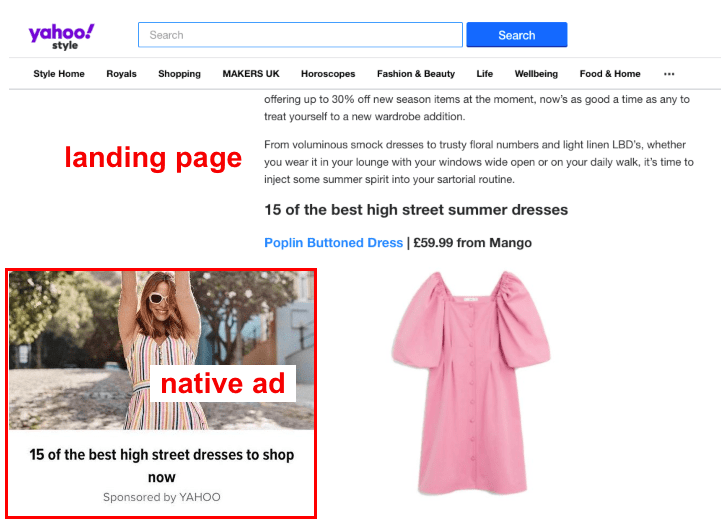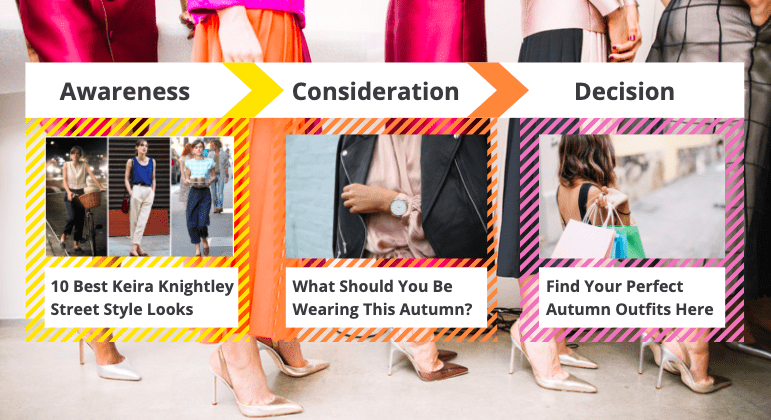
How to Build a Native Ad Strategy for a Fashion Brand from Scratch
Want to stand out from the crowd and go beyond Facebook ads? Or maybe you are just about to start with online advertising and looking for the most cost-effective approach? You should start to build your native strategy as soon as possible.
Whatever your motivation is, native advertising is the answer. Your ads will fit almost seamlessly into the editorial content on HuffPost, The Guardian, CNN, and other premium websites for from $0.015 per click. Sounds good, doesn’t it?
But to make these ads work, you’ll need to develop a well-thought strategy and follow it. In this post, I’ll guide you through the process of preparing, launching, and optimizing your first native ad campaigns for your fashion brand.
Let’s define native advertising first
What’s actually native advertising?
Native advertising is a paid advertising format where ads match the form and function of the content of the media on which they appear. Native ads are usually served through third-party platforms that partner with publishers whose websites your ads will be displayed on.
Native advertising performs particularly well for ecommerce brands, as it allows them to reach wide audiences while having control over placements their ads are served on.
How native ads fit in the page content
For ethics reasons, native ads are usually clearly marked with ‘paid content’ or ‘sponsored’ labels. Here’s an example of native ads placed right below the editorial content.

How fashion brands are approaching native advertising
Among multiple native advertising examples, you can often find ads run by fashion brands.
This campaign by Velasca, a shoe brand, is aimed at building brand awareness by means of storytelling. After coming to their website, some people will be encouraged enough to keep navigating it and get into Velasca’s marketing funnel.
Others might bounce after watching the video, but they’re likely to recall this campaign next time when they’ll want to buy quality shoes.

Most often, fashion brands use native advertising to run lead generation and sales campaigns.
If you’re an affiliate for some fashion brands, there are also lots of opportunities for you to grow your profit with native advertising. Affiliate marketers often use native ads to promote lists of products with affiliate links.

Where does your native ad strategy fit in?
Before you start with campaign creation, think of how you’re going to align your native ad strategy with your overall marketing plan and what’s most important, with your buyer’s journey.
Whether you want to boost traffic to your website or capture leads, do you already know what should be your next step? Before launching your campaign, you’ll need to make sure you know how to retain visitors on your website or move those leads to the next stage.
For fashion brands, the buyer’s journey shouldn’t take long. But it doesn’t mean everyone seeing your ads will be ready to make a purchase.

If you already have a blog, it will be a lot easier for you to run a native ad campaign. You can either use your blog posts as campaign content or retarget your blog readers to take them further down the funnel.
If it’s not the case, you can combine your native advertising efforts with other marketing campaigns, like email marketing or SMM.
For instance, before you start capturing leads’ emails with your native ad campaign, prepare a plan for further efforts you’ll need to take to convert these leads. What type of content are you going to send in your newsletters?
The way native advertising fits in your marketing strategy will also highly depend on your goals. Let’s move to the process of defining them now.
Set goals
At the very beginning of any marketing campaign, you set goals. Native advertising is no exception.
Typically, advertisers select one of the following objectives:
- Boost website traffic
- Attract leads
- Drive sales
After you pick one, you’ll need to go more specific.
Want to boost website traffic? Then define the number of visitors and behavior metrics that you want to reach. Will the bounce rate at 55% work for you?
Do you aim at driving leads or sales? Here you’ll need to know not only how many conversions you want to get but how much every conversion should cost you. At what CPA (cost per action) can you call the campaign ‘effective’?
You can calculate your target CPA based on the revenue you get per customer and the approximate conversion rate.
Roughly, if your product costs $100, and the margin is 40%, you’ll be getting $40 in revenue per conversion. To calculate cost per lead, you’ll need to estimate the lead-to-conversion rate. Let’s say, 1 out of 5 leads will become your customer, which is a 20% conversion rate. If you multiply $40 by 0.2, we’ll get $8 – this is your estimated CPL.
Your goals will determine your action plan for preparing and optimizing your native ad campaigns. Once you launch, this will be the very beginning of the optimization process. By having a clear understanding of what you want to achieve, you can easily identify performance issues and see ways of addressing them.
Allocate campaign budget
How do you know how much you should allocate to your native advertising campaigns?
Instead of making estimates that have nothing to do with real numbers, it’s recommended that you run a $20-30 experiment and get informed by actual results.
Use the data on your CPCs, CTR, and other metrics to calculate the maximum budget you might need to spend. I say ‘the maximum,’ because you’ll judge by newly-built campaigns that will deliver better results after you identify their strengths and weaknesses and optimize them.
Define your target audience
Where is your target audience located? Do they usually shop on mobile or desktop devices?
The answers will not only define the targeting options you’ll go for later but also help you select the right native ad platform (see the next step).
Speaking of the targeting options, it’s always a good idea to start a bit wider than what your first instinct may say, and narrow your reach gradually if necessary.
Interest targeting is also available on most native ad platforms. But unlike Facebook ads, where this approach proves highly effective, native ads often perform better with broader options, such as geo- or device-targeting.
Pick the right platform for native ads
To make the most out of your campaigns, it’s crucial that you select the native ad platform that fits your goals.
There are hundreds of platforms you can choose from. Some of them have wide publisher networks all over the world, others perform well for targeting audiences at specific locations.
Along with typical native ad platforms that have exclusive publisher networks, there are DSPs (demand-side platforms) – they can offer you access to the inventories of a few native ad platforms at once. However, if you’re new to native advertising, it’s better to start with a standard ad platform, like Taboola or Outbrain.
Develop campaign content
Pick or develop content assets you want to promote with your goals in mind. This content will help you qualify the audience that clicks on your ads.
We’ve already illustrated the types of content that might interest people at different stages of the buyer’s journey.
Those three stages (awareness, consideration, and decision) almost always align with 3 types of objectives, which are traffic growth, lead generation, and customer acquisition. And if you want to attract the right people and reach your goals, make sure that your message is tied up to a step in the buyer’s journey.
Here are different examples of native ad strategy that will work well for different goals:
Boost traffic with native ad strategy
To drive new people to your website, the campaign content should be appealing to them and address questions they might have. Don’t try to be overly promotional but offer them something engaging, useful, or surprising.
- How-to’s. Example: How to Look Stylish on A Rainy Day.
- Stories: Example: How Marilyn Monroe Became One of Hollywood’s Most Iconic Beauties
- Seasonal content. Example: 11 Fall Outfit Ideas.
- Lists. Example: The Top 10 Fashion Tips From Stylish Women.
Drive leads
The incentive that encourages people to share their content information with you is called a lead magnet. Fashion and beauty brands often leverage the following lead magnets:
- Quizzes. Example: What’s My Personal Style?
- Discounts. Example: Get A 20% Discount on Your First Order.
- Giveaways. Example: Win Two Looks at Dockers Europe.
- Free consultations. Example: Learn Fashion Secrets From Our Online Personal Stylist for Free.
Acquire customers with your native ad strategy
- Sales. Example: example.com Clothing on Sale – Up to 50% Off on Summer Collection.
- Lists. Example: The Only 5 Work Outfits You Need.
- Special offers for existing customers. This type of content will work well for retargeting campaigns. Example: Get A 30% Discount on Your Next Purchase.
- Seasonal content. Example: The 10 Best Summer T-Shirts for Men.
Create ads
To attract the widest possible audience that might be interested in your offering, your ad headlines should be both catchy and honest. It’s also important to use quality thumbnails that are related to your campaign message.
Follow these best practices for creating effective native ads:
- Include your messaging in your headlines.
- Keep it simple.
- Mention a call to action in your headlines.
- Use photos rather than illustrations.
- Test multiple creatives. Don’t pause old ads as soon as you launch new ones.
- Check Taboola trends for insights into what images and headlines are trending in different verticals.
Keep optimizing your campaigns
After you’ve launched your first native ad campaigns, it’s time for tracking, testing, and ongoing optimization. Check the performance data on a daily basis and make minor adjustments as soon as you identify any issues.
For instance, if your campaigns don’t spend your daily budget, start increasing your CPC gradually.
To launch new tests, wait until you get enough data from your previous campaigns. By leveraging these learnings, you’ll save your time and avoid the same performance issues in your future campaigns.
I also recommend that you launch new campaigns or ads to test new creatives, targeting options, or campaign content. This will allow you to identify what factors affect your campaign performance and scale effectively.
Ready to enjoy great results?
More and more big brands, like Babbel and Blinkist, are investing in native advertising and building their native ad strategy for good reason. If you know who your target audience is, have clear goals, and don’t mind experiments, this advertising approach will prove effective for you.
If you want to manage successful native advertising campaigns with the right strategies for your fashion brand, you should work with digital marketing agencies that are experts in the fashion industry.
We have listed the top fashion marketing agencies in USA to help you succeed online. These agencies have had remarkable success in the fashion industry and you should definitely check out the case studies of these fashion marketing companies with various brands.






















